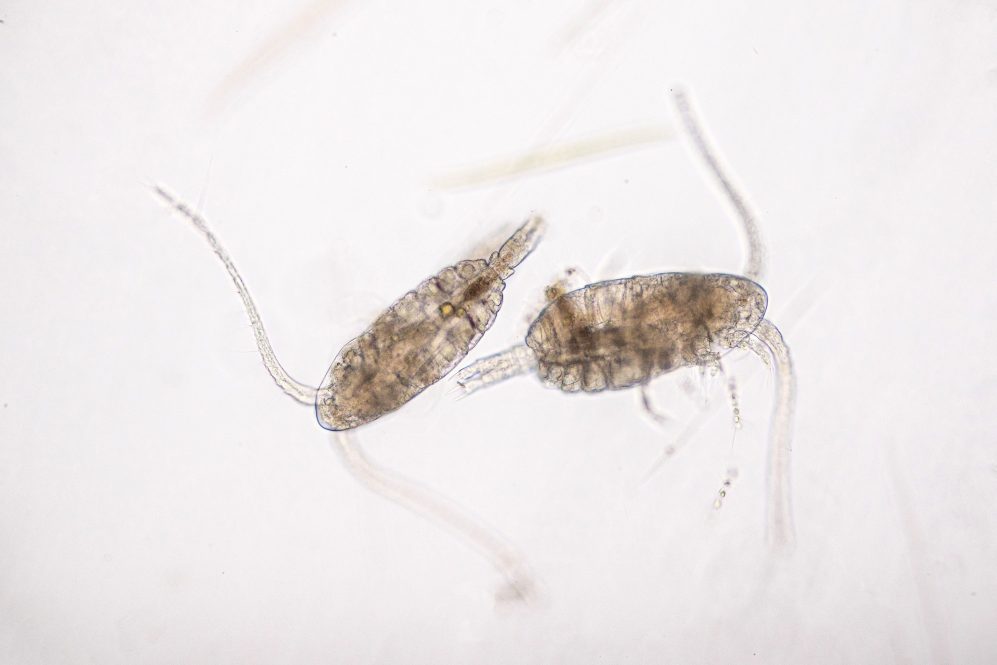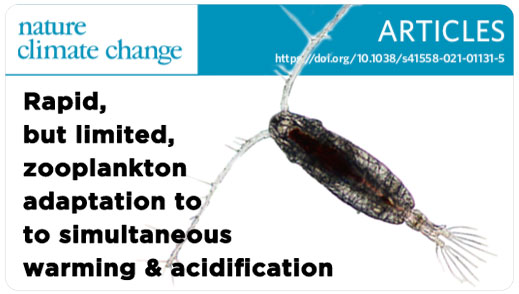Reposted from UConn Today | August 26, 2021 | By Elaina Hancock

The world’s oceans are becoming increasingly stressful places for marine life, and experts are working to understand what this means for the future. From rising temperatures; to acidification as more carbon enters the waters; to changes in the currents; the challenges are multifaceted, making experiments and projections difficult.
Copepods are small marine animals that are abundant, widely dispersed, and serve as major structural components of the ocean’s food web. A team of scientists from the University of Connecticut, Jinan University in China, and the University of Vermont have found that a species of copepod called Acartia tonsa can cope with climate change, but at a price. Their research was just published in Nature Climate Change.
“We have this problem of climate change and in the ocean, it is a multi-dimensional problem because it’s not just the warming, the ocean is becoming more acidic where pH is going down as we pump more CO2, into the atmosphere. Organisms need to cope, they are under more stress, and things are happening very fast,” says Hans Dam, UConn professor of Marine Sciences.
Dam explains that previous studies suggest some animals will be more sensitive than others to changes like shifts in pH. Prior studies with copepods showed they are not particularly sensitive to pH changes, but Dam points out those studies were only done with a single generation, or few generations, to a single stressor and shows the ability to acclimate rather than adapt. This new study not only looks at adaptation across 25 generations, it also considered both ocean warming and acidification (OWA), something that few studies have done until now.
“If you want to study the long-term effects, you must consider the fact that animals will adapt to changes or stress in the environment, but to do that you have to do the right experiments. Most people do not do those experiments with animals because it takes a long time to study in multiple generations.”
The researchers looked at fitness, or the ability of a population to reproduce itself in one generation, and how fitness would change through generations in increased OWA conditions. The first generation exposed to new OWA conditions suffered extreme reductions of over 50% of population, says Dam. It was as if OWA was a big hammer that greatly reduced the population fitness. By the third generation, the population seemed to have mostly recovered. However, by the 12th generation, the researchers began to see declines once again.
Though the copepods were able to adapt, the adaptation was limited because fitness was never fully recovered, and the researchers suspect there are some antagonistic interactions at play, leading to a tug of war situation between adaptation to warming and to acidification. These antagonistic interactions complicate predicting what responses can be expected.
James deMayo, co-author and UConn Ph.D. student adds, “Perhaps what’s important to emphasize with this project is that the effects of warming combined with acidification are not the same for every generation or organism that is adapting to that environment. That’s suggested by the data and why the adaptation is limited. While within intermediate generations, organisms might be very well adapted, in later generations, the effects of warming and acidification start to behave differently on the population. That’s one of the exciting parts about the research. It’s not a static, expected result for how organisms or their populations are going to continue to grow or decay.”
For example, deMayo explains, if you took individuals in later generations that had adapted to the experimental OWA conditions and placed them into the conditions of today’s ocean, they would not fare as well.
“That’s one negative consequence, that ability to not tolerate environmental shifts is a cost and an unpredicted consequence for evolutionary adaptation in a lot of systems, not just in copepods,” says deMayo.

The researchers point out that studies looking at single stressors run the risk of making overly simplified inferences about an organism’s ability to adapt, an especially risky proposition when making conclusions about such an integral component of the food web as copepods.
“Particularly when you involve living organisms, there are complexities that you can’t predict,” says Dam. “A priori, you might make the predictions, but you have no certainty that they’re going to unfold that way. In biology these are referred to as ‘emergent properties’ or things that you cannot predict from what you know in advance and this research is a good example.”
In thinking back to the hammer comparison, Dam says impacts in the copepod population have ripple effects through the whole food web and beyond.
“If fitness decreases by say, 10%, down the road we will have a 10% decrease in population size and since these animals are the main food source for fish, a 10% decrease in the world fishery is pretty significant,” says Dam. “And this is really the best-case scenario since in the lab, they’re essentially living in hotel-like conditions so that 10% isn’t taking into consideration other factors like predation or disease. In the real world we could see fitness recovery is actually much worse.”
Additionally, Dam points out another implication is that copepods sequester CO2 and reductions in their numbers reduce the ocean’s carbon sequestration capabilities, bad news at a time when more carbon sequestration is needed.
While the research offers promise for rapid adaptation, it is a reminder that as with many things in nature there’s a catch.
“There is some welcoming news, that yes, there is a recovery of fitness but there is also sobering news that the evolutionary rescue is not complete. There’s no such thing as a free lunch,” says Dam.
